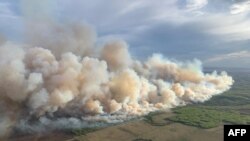A large wildfire is slowly approaching the major Canadian oil sands city of Fort McMurray, and around 6,000 people in four suburbs have been told to evacuate, local officials said on Tuesday.
The fire, fueled by tinder-dry conditions and high winds, has been threatening the city in the western province of Alberta since last week. It is now about 13 km (8 miles) away to the southwest.
Alberta Wildfire information officer Josee St-Onge said the blaze grew significantly on Tuesday and noted winds from the southwest were gusting as high as 40 km/hr (24.8 mph).
"Unfortunately, these are not favorable winds for us, and the fire will continue to advance towards the town until we see a wind shift," she told an online media briefing.
"We're seeing extreme fire behavior. Smoke columns are developing, and the skies are covered in smoke. ... Firefighters have been pulled from the fire line for safety reasons."
The fire has grown in size and is now more than 10,000 hectares (25,000 acres), officials said.
In a statement, the local authority said residents in the suburbs of Abasand, Beacon Hill, Prairie Creek and Grayling had to leave by 4 p.m. Mountain Time.
In 2016, a huge wildfire in Fort McMurray forced the evacuation of 90,000 residents and shut in more than a million barrels per day of oil output.
People in other parts of Fort McMurray not under evacuation orders are also starting to leave, said resident Elsie Knister, as she prepared to depart her downtown neighborhood Tuesday afternoon.
"People aren't waiting for an order, they're just going already," Knister, who also evacuated in 2016, said in a phone interview. "I feel sunk. I'm 71, and I don't want to go through this again. It's horrible."
Officials said Fort McMurray is better prepared to fight the fire than it was in 2016. Much of the boreal forest surrounding the city burned in the 2016 fire, meaning there is less fuel available to the blaze now.
"This fire activity is very different than (in) 2016. ... We have an abundance of resources, and we are well-positioned to respond to this situation," said regional fire chief Jody Butz.
He said evacuees were encouraged to leave Fort McMurray but could remain in other neighborhoods in the city if they wished. The city has 250 to 300 firefighters available to help protect structures, Butz added.
Fort McMurray is the hub for Canada's oil sands industry, which produces roughly 3.3 million barrels per day, two-thirds of Canada's total output.
Companies including Suncor Energy, Canadian Natural Resources Ltd and Imperial Oil have oil sands projects within 150 km of the city, and many workers live in Fort McMurray.
"This will put more people on edge. We'll have to see if the actual production sites themselves come under threat," said Martin King, an analyst at RBN Energy.
"Back in 2016, the fires themselves were getting close, so the companies evacuated people for safety. And of course, the people that worked in these sites were evacuated and had nowhere to go, so they ended up shutting down production."
In neighboring British Columbia, a wildfire burning near Fort Nelson in the province's northeast grew in size but is moving away from the town, offering some relief to around 3,000 residents who were forced to evacuate, the provincial wildfire service said on Tuesday.








